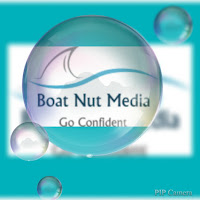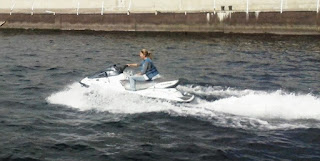TIE ONE ON
USE THE RIGHT SIZE LINES AND FENDERS
Why is it every year I see boats get damaged from the docks and other boats simply due to the fact that the owner doesn't invest in the right lines and fenders for their boat? Your boat is only as safe as the way you tie up and the fenders that you protect it with.
I hope you are not one of those boaters who rummages around only to grab whatever you can find to use as a line. Perhaps you have seen that boat, the one that is tied up with yellow nylon line available at your closest hardware store. The most ridiculous is the boat that is tied up with one long line, the owner has usually robbed the anchor locker and ties the boat up from front to back all in one long mess of loops and knots. Your boat is an investment, so you need to invest in the correct size of line and the correct length of line. To tie up your boat, oh yah and your fenders to have to be the correct size and type for the mooring application.
If you want to be fancy and tie chain knots please learn how to end the knot properly. It is mind boggling the amount of damage to boats caused by these problem. Bad knots, crappy lines and fenders for a row boat on a 32 foot cruiser. There are plenty of guides out there to help you choose the right lines for your boat and a standard rule of thumb to measure them.(so they do not get tangled around the prop of your boat or your neighbor's boat). You got to love it when your neighbor's boat has twenty feet of spare line dangling in the water from a cleat right next to your out drive.
When you tie up your boat follow the above picture. You must have aft and forward lines complete with two spring lines, one facing forward and one facing aft.
Here is a little advise for power boaters who want to have the swim platform backed right up to the dock.
When you first get your boat in the correct position at the dock .The first two lines that you set are the aft or stern line this is the line that holds the stern of the boat to the dock and generally controls the distance from the hull to the dock. The next line is the forward spring line, this is the line that determines the amount of backward motion the boat will have. If you are tight up against the dock with the swim platform this line must be tight to prevent the platform from hitting the dock. Once these two lines are established it is time to tie the rest. Starting with the bow line. You must allow the bow to find its natural position. Tying this line to tight will pull the transom away from the dock and add unnecessary load on the aft cleat. The boat needs to sit with the center line of your boat parallel to the dock
The last line you set is the aft spring line. This line controls the amount of forward motion the boat will have. It is the spring lines that do all the work to keep the boat in place the aft and bow lines simply set the distance from the dock. If the cleats on the dock and your boat cleats will not line up to allow for the correct line set up, (In other words the aft or bow lines end up too long or the center cleat on the dock doesn't allow you to balance the length of the spring lines) then you should ask the marine to move the cleats on the dock in your slip. If they cannot do this find a better slip for your boat to live in. Your boat will get damaged if you do not have it tied up right.
More tie up tips
When you buy lines buy two sets. One set you will fix to your dock at the marina, so all you have to do is slip the loop end of the lines on the boat cleats every time you come to home port. This way the boat is always in the same place and time to tie up is reduced. These lines will have to be adjusted time to time as the motion of the boat or changing water levels will affect the lengths and you will find yourself against the dock at the swim platform.
If you have the boat with the swim platform against the dock it is a great idea to add another line from the aft cleat on the off the dock side ran to a cleat on the dock that is behind the boat and to the same side as your off the dock cleat this will add stability when getting on and off the boat.
Fenders Boaters Fenders
Spend some money and time at this it will pay off. If you cannot find a location to tie the fenders to cleats on your boat then purchase fender accessories. The ones that hang on the rails are great. Take a picture of the boat in the slip and go to your marine parts store they should help you sort out the fittings you need.
If you have posts or any other obstruction on the dock you can always tie fenders to the dock. Manufacturers make a multitude of screw down fender variations to accommodate your needs. Just remember if you are a seasonal boater to take them with you in the fall. Always keep fenders on both sides of your boat as your neighbor may have a problem one day and use your boat as a spot to stop or turn his or her boat on (this happens more than I care to admit). if you are in a tidal body of water you must remember that the fenders may be set for high tide but at low tide they may be all together in the wrong location.
Something almost all boaters used to do but you don't see this anymore, I assume it is due to fender design. Lifting the fenders while running today requires a person to go around and pull the fenders up onto the deck. What used to happen was a small line was tied to the bottom of the most forward fender and with the fenders hanging vertical the line was then attached to the bottom of each fender running aft. From the bottom of the last or most aft fender the line was long enough to tie to the aft corner cleat. This way one person from the aft cockpit could raise all the fenders on the one side by pulling on the rope the fenders would swing aft and up. When they reached the position that was up far enough you simply tie the line off to the aft corner cleat and away you go. Easy for the captain or help to do, and so easy to let them back down. This system did a double duty. It also prevented the fenders from rolling up and ending up on the dock.
As with every thing else you get what you pay for, cheap out and you will be paying for it in repair bills.
Author RP
To guarantee access to all of Boat Nut Magazine articles, pictures and featured services visit the official Boat Nut Magazine ©™ website. Be sure to reply to the Boat Nut Association registration on our site for the latest Boat Nut weekly and monthly news letters and opportunities.
Copyright 2015 © Boat Nut Media, Toronto, Ontario. All rights reserved. No part of this information/publications may be stored in a retrieval system, transmitted, or reproduced in any way, including but not limited to photocopy, magnetic, or other record, without prior agreement and written permission of the publisher, Boat Nuts Media ©™ No liability is assumed with respect to the information provided







